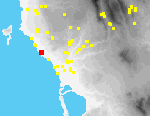 G03 Vromoneri Pigadia
G03 Vromoneri Pigadia
The site of Pigadia is located on the the crest and slopes of a low NW-SE ridge[110.08] approximately 600 m. N of the hamlet of Vromoneri, and is bisected by a dirt road that here crosses the ridge. Weedy olive groves cover much of the site; there are two new villas on the S side of the road. Artifacts were most plentiful S of these houses in and around several piles of rocks that had been cleared from adjacent fields; in the yards of the houses themselves; and immediately north of the houses, on both sides of the road.
In 1973-74 a farmer discovered in his field at Pigadia two pithoi that had been set intact into the ground and were covered with irregular limestone slabs; in the course of removing them, sherds of Mycenaean vessels were found (JHS-AR 1979-80:33; ADelt 1973-4:316). We have not been able to learn the precise location of this excavation but it seems probable that the pithoi were found near the new houses. In 1993 we were shown a fragment from a similar pithos that is now in possession of one of their owners.
At the northern end of the site, an old house is surrounded by an extensive wall that appears to enclose not only it, but an extensive area of cultivated fields in the vicinity; an arched gate leads through the wall to the house.[090.24] On the opposite side of the road, are preserved parts of a similar wall around a second old house; farther W, near the end of the the ridge, sections of yet another wall of similar construction can be seen. The walls in all cases are capped by a beveled concrete molding,[110.06] and are similar in style to others in the study area (e.g., at Tragana Hasanaga [C4] and Vromoneri Ayia Sotira [G2]).
Prehistoric material was mainly found in the field immediately SE of the modern houses, over an area of no more than 0.75 ha. Early Modern is concentrated around the modern houses. HL-R ceramics are in contrast found in all parts of the the site.
The LH IIIA-B pottery is recognized by shapes (kylix, dipper); the MH III-LH (II) by its fabric (orange to brown with tan clay inclusions). Historical ceramics predominate, however, chiefly of Hellenistic-Roman and Early Modern date.